Nov 6 2019, 10:11 am in Animal Veterans, animal war heroes
November is Veterans Month
Veterans come in many sizes shapes and species. Yeah! Species. Animals have served and are serving around the world and many are certified heroes.
I believe we are most familiar with military working dogs (MWD) and K9 officers. Dogs have been in warfare since ancient times used as scouts, sentries and trackers. They sniff out explosive devises saving countless lives. They are assigned to safe guard generals and political personnel on visits outside the country. They’ve suffered severe trauma, lost limbs and been honored for their bravery with medals.
Recently Social Media was ablaze over the heroism of this military working dog assigned to 1st Special Forces Operational Detachment-Delta, known as Delta Force.
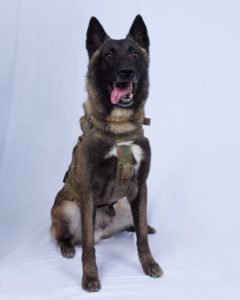
And then there’s
Layka
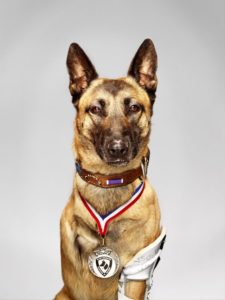
a Belgian Malinois, shot four times in 2014 at point-blank range by enemy forces in Afghanistan. Despite her injuries, she attacked and subdued the shooter, protecting her handler, and other members of the team.
Sgt Stubby, a war hero from WWI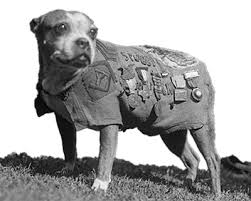
He wandered into the training encampment of the Massachusetts of 102nd infantry in 1917. When the unit shipped out to France, Stubby was smuggled aboard ship. On the battle field, the dog alerted his friends to German attacks. He was wounded by a hand grenade, gassed several times, and once found and held a German spy by the seat of the pants until the troops could complete the capture.
When his master was wounded, Stubby accompanied him to the hospital and made rounds to cheer the troops. Sgt. Stubby survived the war and Gen. John Pershing, personally awarded him a gold medal for one of his many efforts. He became a highly decorated dog, among his medals a Purple Heart, and various veteran’s awards. Stubby returned home at the end of the war and became quite the celebrity. He was made a lifetime member of the American Legion, the YMCA, and the Red Cross. He lived at the Y and made recruiting tours for the Red Cross. Stubby passed on in 1926, he was preserved and displayed with his medals at the Smithsonian Institution.
Now let’s talk about some of the other animal heroes maybe not so well known like Staff Sergeant Reckless,USMC
The Staff Sergeant was a beer-guzzling, American hero war horse who bravely transported ammunition and carried wounded Marines to safety under enemy fire in the Korean War
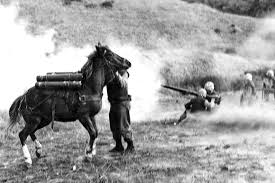
She served with the Recoilless Rifle Platoon, Anti-Tank Company, 1st Marine Division, was bought for $250 at a race track in Seoul during the war. The marines taught her to walk over trip wires, avoid incoming enemy fire and deliver huge packs of ammunition during battle.
During the five day Battle of Outpost Vegas in 1953 in one day she made 51 solo—that’s by herself— trips from the Ammunition Supply Point to the firing sites. Marine Corps history say this battle was particularly savage and Reckless was in the middle of it. Enemy soldiers could see her as she made her way across the deadly “no man’s land” rice paddies and up 45-degree mountain trails to the firing sites. “It’s difficult to describe the elation and the boost in morale that little white-faced mare gave Marines as she outfoxed the enemy—remember she was on her own—bringing vitally needed ammunition up the mountain,” Sgt. Maj. James E. Bobbitt recalled.
She carried 386 rounds of ammunition (over 9,000 pounds – almost FIVE TONS! — of ammunition), walked over 35 miles through open rice paddies and up steep mountains with enemy fire coming in at the rate of 500 rounds per minute. She would carry wounded soldiers down the mountain, unload them, get reloaded with ammo, and off she would go back up to the guns. She also provided a shield for several Marines who were trapped trying to make their way up to the front line. Wounded twice, she didn’t let that stop or slow her down.
Her heroics defined the word “Marine.” She was BELOVED by the Marines. They took care of her better than they took care of themselves – throwing their flak jackets over her to protect her when incoming was heavy, risking their own safety.
Her Military Decorations include two Purple Hearts, Good Conduct Medal, Presidential Unit Citation with star, National Defense Service Medal, Korean Service Medal, United Nations Service Medal, Navy Unit Commendation, and Republic of Korea Presidential Unit Citation.
There is a book about Sgt. Reckless. She has a face book page and she has a bronze statue.
Okay I find this one really well, odd. But Wojtek the bear was bought and adopted by Polish soldiers making their way back east after they were released from a prison camp in Siberia in 1942.
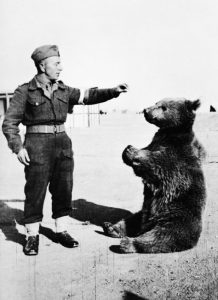
When the unit re-entered the war the only way they could take Wojtek with them was to make him an official soldier. So he became Corporal Wojtek of the artillery supply unit. Wojtek fit in quite well—his favorite activities included wrestling, drinking beer, and Taking showers.
The 440-pound bear became an ammo carrier that ferried heavy artillery rounds to the guns and he was good at his job. His finest hour came during the Battle of Monte Cassino, when he loaded 100-pound boxes of artillery shells into trucks all day long, every day until the battle was won. The army honored Wojtek’s service by putting his image, carrying ammo, on the unit’s official badge. After the war, Wojtek was housed at the Edinburgh Zoo until his death in 1963.
Then there are our feathered heroes.
Quite a few carrier pigeons were honored for their service in war. Cher Ami, a messaging pigeon serving in the Argonne Forest with the 77th Infantry. Joe an American pigeon.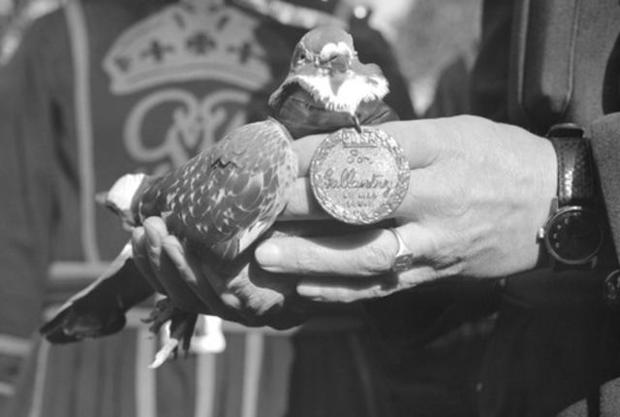
In WW1, Cher Ami, a messaging pigeon was serving in the Argonne Forest with the 77th Infantry Division when the battalion of 550 soldiers she was with was completely cut off by German forces. After four days of heavy fighting, friendly artillery decided the battalion must have surrendered already and began firing on them. Ouch! Remember this WW1 could get on the cell and tell them to knock that crap off. They had to use carrier pigeons. Three were sent out and quickly shot down. Cher Ami, with a hole in her chest and a nearly amputated leg, got back into the air and delivered her message. Wow! 194 soldiers made it out alive thanks to her actions.
Joe an American pigeon from Fort Monmouth, N.J. was in Italy. The British advanced on a town the Germans had abandoned and… that U.S. planes were about to strike. Radio communications couldn’t reach the airfield 20 miles away to tell them the German were gone. Joe saved the day. He carried a message, covering the entire 20 miles in only 20 minutes. His message reached the airfield just as the bombers were taxiing for take off. With only five minutes to spare, the bombing run was canceled, saving the lives of at least 1000 British troops.
Joe retired to the Detroit Zoological Gardens until he died in 1961 at age 18. His body was mounted and displayed for years at Fort Monmouth, which closed in 2011.

A pig, Tirpritz, was carried on the German warship Dresden in 1914 as a food source. The Dresden was sunk in battle with the HMS Glasgow off the coast of South America. Tirpitz escaped the sinking ship and swam to the Glasgow. The crew brought him aboard and adopted him as a mascot, named him after German admiral Alfred von Tirpitz and he spent a year aboard. Tirpitz was eventually auctioned off as pork, but in his final act he raised £1785 for the British Red Cross. His mounted head is on display at the Imperial War Museum in London. Tirpitz’s trotters were made into handles for a carving set that traveled with the Glasgow in World War II, giving Tirpitz the dubious honor of serving aboard the ship in two wars.
Rita
Nov 18 2016, 1:50 pm in animal war heroes, MWD, Sgt Reckless, Sgt Stubby
War heroes come in many sizes shapes and species. Yeaph! Species. There are many animal war heroes. I believe we are most familiar with military working dogs (MWD) and K9 officers. Dogs have been in warfare since ancient times used as scouts, sentries and trackers. They sniff out explosive devises saving countless lives. They are assigned to safe guard generals and political personnel on visits outside the country. They’ve suffered severe trauma, lost limbs and been honored for their bravery with medals and have memorials.
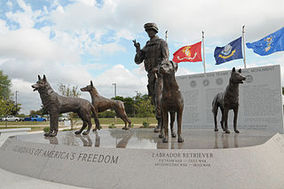
Layka, a Belgian Malinois, was shot four times at point-blank range by enemy forces in Afghanistan. Despite her injuries, she attacked and subdued the shooter, protecting her handler, and other members of the team. Photographer, Martin Schoeller, did an amazing photoshoot of Layka, the now three-legged dog, for National Geographic. I’d love to share his photos here but I don’t have permission. I can give you the link here to his page to see this brave beautiful dog.
Sgt Stubby, a hero dog from WWI,  wandered into the training encampment of the Massachusetts of 102nd infantry in 1917. When the unit shipped out to France, Stubby was smuggled aboard ship. On the battle field, the dog alerted his friends to German attacks. He was wounded by a hand grenade, gassed several times, and once found and held a German spy by the seat of the pants until the troops could complete the capture.
wandered into the training encampment of the Massachusetts of 102nd infantry in 1917. When the unit shipped out to France, Stubby was smuggled aboard ship. On the battle field, the dog alerted his friends to German attacks. He was wounded by a hand grenade, gassed several times, and once found and held a German spy by the seat of the pants until the troops could complete the capture.
When his master was wounded, Stubby accompanied him to the hospital and made rounds to cheer the troops. Sgt. Stubby survived the war and Gen. John Pershing, personally awarded him a gold medal for one of his many efforts. He became a highly decorated dog, among his medals a Purple Heart, and various veteran’s awards. Stubby returned home at the end of the war and became quite the celebrity. He was made a lifetime member of the American Legion, the YMCA, and the Red Cross. He lived at the Y and made recruiting tours for the Red Cross. Stubby passed on in 1926, he was preserved and displayed with his medals at the Smithsonian Institution.
Now let’s talk about some of the other animal heroes maybe not so well known like Staff Sergeant Reckless,USMC

The Staff Sergeant was a beer-guzzling, American hero war horse who bravely transported ammunition and carried wounded Marines to safety under enemy fire in the Korean War
She served with the Recoilless Rifle Platoon, Anti-Tank Company, 1st Marine Division, was bought for $250 at a race track in Seoul during the war. The marines taught her to walk over trip wires, avoid incoming enemy fire and deliver huge packs of ammunition during battle.
During the five day Battle of Outpost Vegas in 1953 in one day she made 51 solo—that’s by herself— trips from the Ammunition Supply Point to the firing sites. Marine Corps history say this battle was particularly savage and Reckless was in the middle of it. Enemy soldiers could see her as she made her way across the deadly “no man’s land” rice paddies and up 45-degree mountain trails to the firing sites. “It’s difficult to describe the elation and the boost in morale that little white-faced mare gave Marines as she outfoxed the enemy—remember she was on her own—bringing vitally needed ammunition up the mountain,” Sgt. Maj. James E. Bobbitt recalled.
She carried 386 rounds of ammunition (over 9,000 pounds – almost FIVE TONS! — of ammunition), walked over 35 miles through open rice paddies and up steep mountains with enemy fire coming in at the rate of 500 rounds per minute. She would carry wounded soldiers down the mountain, unload them, get reloaded with ammo, and off she would go back up to the guns. She also provided a shield for several Marines who were trapped trying to make their way up to the front line. Wounded twice, she didn’t let that stop or slow her down.
Her heroics defined the word “Marine.” She was BELOVED by the Marines. They took care of her better than they took care of themselves – throwing their flak jackets over her to protect her when incoming was heavy, risking their own safety.
Her Military Decorations include two Purple Hearts, Good Conduct Medal, Presidential Unit Citation with star, National Defense Service Medal, Korean Service Medal, United Nations Service Medal, Navy Unit Commendation, and Republic of Korea Presidential Unit Citation.
There is a book about Sgt. Reckless. She has a face book page and she has a bronze statue.
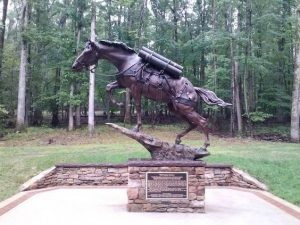
Okay I find this one really, well, odd.  But Wojtek the bear was bought and adopted by Polish soldiers making their way back east after they were released from a prison camp in Siberia in 1942.
But Wojtek the bear was bought and adopted by Polish soldiers making their way back east after they were released from a prison camp in Siberia in 1942.
When the unit re-entered the war the only way they could take Wojtek with them was to make him an official soldier. So he became Corporal Wojtek of the artillery supply unit. Wojtek fit in quite well—his favorite activities included wrestling, drinking beer, and Taking showers.
The 440 pound bear became an ammo carrier that ferried heavy artillery rounds to the guns and he was good at his job. His finest hour came during the Battle of Monte Cassino, when he loaded 100-pound boxes of artillery shells into trucks all day long, every day until the battle was won. The army honored Wojtek’s service by putting his image, carrying ammo, on the unit’s official badge. After the war, Wojtek was housed at the Edinburgh Zoo until his death in 1963.
Then there are our feathered heroes.
Quite a few carrier pigeons were honored for their service in war. Cher Ami, a messaging pigeon serving in the Argonne Forest with the 77th Infantry. Joe an American pigeon.
In WW1, Cher Ami, a messaging pigeon was serving in the Argonne Forest with the 77th Infantry Division when the battalion of 550 soldiers she was with was completely cut off by German forces. After four days of heavy fighting, friendly artillery decided the battalion must have surrendered already and began firing on them. Ouch! Remember this WW1 could get on the cell and tell them to knock that crap off. They had to use carrier pigeons. Three were sent out and quickly shot down. Cher Ami, with a hole in her chest and a nearly amputated leg the little bird got back in the air and delivered her message. Wow! 194 soldiers survived thanks to her.
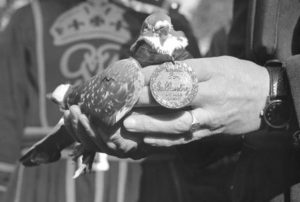
Joe an American pigeon from Fort Monmouth, N.J. was in Italy. The British advanced on a town the Germans had abandoned and… that U.S. planes were about to strike. Radio communications couldn’t reach the airfield 20 miles away to tell them the German were gone. Joe saved the day. He carried a message, covering the entire 20 miles in only 20 minutes. His message reached the airfield just as the bombers were taxiing for take off. With only five minutes to spare, the bombing run was canceled, saving the lives of at least 1000 British troops.
Joe retired to the Detroit Zoological Gardens until he died in 1961 at age 18. His body was mounted and displayed for years at Fort Monmouth, which closed in 2011.
Do you know of any other animal heroes?


